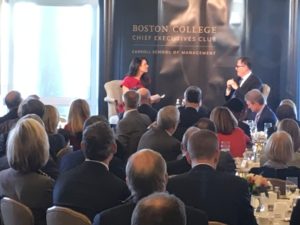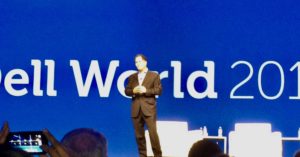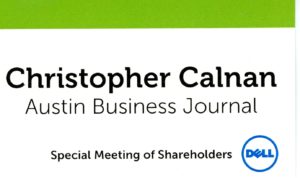 BOSTON — The amount of lobbying money Dell Technologies Inc. spent spiked in the run up to last year’s election amid four consecutive years of losses for the Texas tech giant.
BOSTON — The amount of lobbying money Dell Technologies Inc. spent spiked in the run up to last year’s election amid four consecutive years of losses for the Texas tech giant.
The amount raised by the Round Rock, Texas-based company’s political action committee (PAC) doubled versus 2015 largely with donations from company executives who regularly contributed to the fund, filings with the Federal Election Commission show.
The sharp increase came the same year Dell completed its $58.1 billion acquisition of Massachusetts-based EMC Corp., a deal that resulted in Dell absorbing EMC’s lobbying activities. But the merger did little to put an end to Dell’s annual losses and it’s too early to tell if the lobbying can help Dell reverse its downward trend.
Lobbying experts said it’s not unusual for companies to tap its top executives as regular contributions to PACs that promote specific industry and legislation benefiting the business. A look at Dell’s federal filings reveals a web of connections and provides a glimpse into the role money can play when government business intersects with big business.
Earlier this year, President Donald Trump appointed to CEO Michael Dell to a 28-person committee of national business leaders. (The manufacturer’s council later fell apart when several members quit in protest to Trump’s refusal to criticize white supremacists that marched in August in Charlottesville, Virginia.)
LOBBYING ACTIVITY
Dell raised or spent more than $5 million on lobbying during 2016 versus $2.5 million in 2015. The total included $1.8 million attributed to its Dell EMC subsidiary, $610,000 from VMware Inc., and $180,000 from Virtustream, according to the Center for Responsive Politics.
By comparison, IBM Corp. spent $4 million on lobbying last year compared with $4.6 million in 2015. Hewlett Packard Enterprise spent $4.8 million in 2016 versus $2.1 million in 2015. Online retailing giant Amazon.com Inc. spent $11.3 million in 2016 compared with $9.4 million in 2015, the CRP reported.
It’s unclear why Dell’s spending on lobbyist increased so sharply last year, and company spokeswoman Lauren Lee didn’t respond to requests for an explanation.
It’s not uncommon for execs to contribute to a business PAC because workers are the only eligible contributors. The company can’t contribute directly to candidates from the corporate treasury so they raise money from employees, CRP Senior Researcher Dan Auble said.
Dell and its PAC enlisted 46 lobbyists, 34 of whom were revolvers, or lobbyists who had previously held government positions. Lobbyists listed in Dell’s federal filings include Michael J. Kennedy, a VMware lobbyist who was Sen. Orrin Hatch’s (R-Utah) chief of staff from 2010 to 2014.
 PROSPECTIVE PROFITS
PROSPECTIVE PROFITS
Dell has posted declining revenue every year since 2011 (fiscal 2012). That trend changed during fiscal 2017 largely due to the acquisition of EMC.
Dell’s 2016 acquisition of EMC has boosted Dell’s revenue but hasn’t helped its bottom line very much. In March, Dell posted a $3.7 billion net loss ($2.1 billion of which attributed to EMC) on revenue of $61.6 billion during fiscal 2017, according to the SEC filing.
Dell also reported a loss of $1.1 billion on revenue of $50.9 billion during fiscal 2016 following a loss of $1.1 billion on revenue of $54.1 billion in fiscal 2015. During the first six months of the current fiscal year, the company posted revenue of $37.1 billion. (Although Dell is privately held, it reports quarterly financials because of the tracking stock it sold when buying EMC and VMware. It also hosts quarterly conference calls with Wall Street analysts.)
Dell is not unlike other technology giants operating in the red. The lack of profits has become more common in recent years with companies such as Uber Inc., Amazon.com Inc. and Twitter Inc. They’re more frequently playing the long game by making investments in innovation for market dominance and future growth instead of focusing on short-term profits.
On Nov. 28, Michael Dell told a luncheon audience of 400 Boston executives that he was repositioning the company with a long-term approach of selling technology that businesses need to manage the massive amount of data they’ve been collecting.
It’s based on “thinking about the business really from the perspective of how do we help our customers, how do we solve the unsolved problems, how do we think about meeting with our customers over a three-, five-, 10-, 20-year period,” he said.
Dell took on about $46 billion in debt for its EMC buyout and it has paid off $7 billion of that amount. However, it still reports debts of $49.4 billion, SEC filings indicate. The gamble Dell is taking is whether it can pay off that debt and start generating profits before its business model or technology become outdated.
It’s important Dell reduce its debt load so it can take on more debt for future merger-and-acquisition deals, said longtime Dell consultant Roger Kay, president of Boston-based Endpoint Technologies Associates Inc.
“I can’t imagine they’re done buying other companies,” he said.
Michael Dell told the Boston executives his company has invested $12.7 billion on research and development during the last three years. But that figure contradicts Dell’s latest SEC filing indicating the company spent $4.6 billion: $2.6 billion last year, $1 billion in fiscal 2016 and $920 million in 2015.
Lee subsequently said the $12.7 billion Michael Dell cited was actually the total R&D spending for seven companies Dell Technologies acquired when it bought EMC in late 2016. So it was mostly spending that predated Dell’s ownership.
Dell has attempted to transition from a company best known for personal computers to one offering a full line of tech products and services. The shift was sparked by the slim profit margins generated by commoditized computers versus the profits provided by software and storage. Dell is now structured with two segments: client solutions (computers) and enterprise solutions group (networking infrastructure such as software, servers and storage).
The company operates manufacturing plants in the United States, Malaysia, China, Brazil, India, Poland and Ireland. It employed about 138,000 workers at the end of its last fiscal year, the SEC filings show.

Michael Dell by World Economic Forum, Christian Clavadetscher
POLITICAL CONNECTIONS
In 2010, the U.S. Supreme Court ruled that company PACs could contribute unlimited amounts to political campaigns. Since then, the number of politically active U.S. companies has sharply increased, Reuters reported in 2015, citing data compiled by the Business Industry Political Action Committee.
Dell raised more than $500,000 last year through the Dell Technologies Political Action Committee that operates in Washington, D.C. The PAC lists affiliations with the EMC Corp. PAC and the VMware Inc. PAC, according to the filings. Dell’s PAC reported receipts of $157,135 in 2014 when it was called the Dell Inc. Employee Political Action Committee.
Its well-connected lobbyists included Chris Alsup, former chief of staff for U.S. Rep. Michael McCaul (R-Texas), chairman of the homeland security committee, the CRP reported.
Before working for McCaul, Alsup was Dell’s senior government affairs manager in Washington, D.C., from 2011 to 2015. He was also a legislative director for U.S. Rep. John Carter (R-Texas) for nearly nine years, his online profile indicates.
John Howard is listed as a Dell lobbyist with an environmental background. He’s the onetime director of environmental and natural resources in Texas, and was also the president of Keep Texas Beautiful and chairman of the Texas Water Foundation.
Dell lobbyists Ashley E. Davis is the former special assistant to the director of Homeland Security from 2001 to 2003, and R. James Nicholson is the former secretary of veterans affairs and once-chairman of the Republican National Committee, filings indicate.
In 2016, the Dell PAC spent $303,720 of the $500,000 it raised. Fifty-two percent of the recipients were Republicans and 48 percent Democrats. Donation amounts range from $1,000 to $10,000.
The largest recipients were Carter, Rep. Joaquin Castro (D-Texas) and Rep. Will Hurd (R-Texas) — each receiving $10,000. McCaul received $8,500, filings indicate.
The list of donors to Dell’s PAC is littered with senior names connected with the company. In addition to Michael and Susan Dell ($5,000 apiece), the donor list includes former EMC Corp. executive William Scannell, Dell Vice President Michael Young, Chief Financial Officer Tom Sweet and Dell President Marius Hass.
The issues that attracted the most activity from Dell lobbyists during 2016 were related to patent reform, specifically the Patent Act and the Innovation Act, according to the CRP.
The Patent Act addresses patent litigation reform and the Innovation Act relates to rules and regulations affecting patent infringement lawsuits. The legislation is designed to reduce the number of such suits.
Dell’s lobbying activity was also related to the Venue Equity and Non-Uniformity Elimination Act of 2016, a bill designed to change rules related to where patent actions may be filed.
Trump’s tax reform plan includes a proposal to reduce the tax rate on corporate capital repatriated from abroad. Tech giants such as Apple Inc., Microsoft Corp. Cisco Systems Inc. and Oracle Corp. reportedly have a nearly $500 billion overseas and proposed changes would save them billions in expenses.
During a Dec. 7 conference call with analysts, Sweet declined to provide specifics about the effect Trump’s proposed legislation would have on Dell. However, he did say the company is supporting a possible update to 30-year-old regulations.
“ … We’re big fans of territorial tax and those types of policy changes that they’re contemplating,” he said. “So obviously there are some headwinds in that tax proposed legislation that we’re looking at and that we are making sure that our voice is heard …”
 BOSTON — Imagine a poorly reviewed restaurant that’s infamous for crappy food and service yet enjoys long lines of eager customers. That’s the situation in which the technology industry finds itself today.
BOSTON — Imagine a poorly reviewed restaurant that’s infamous for crappy food and service yet enjoys long lines of eager customers. That’s the situation in which the technology industry finds itself today.









